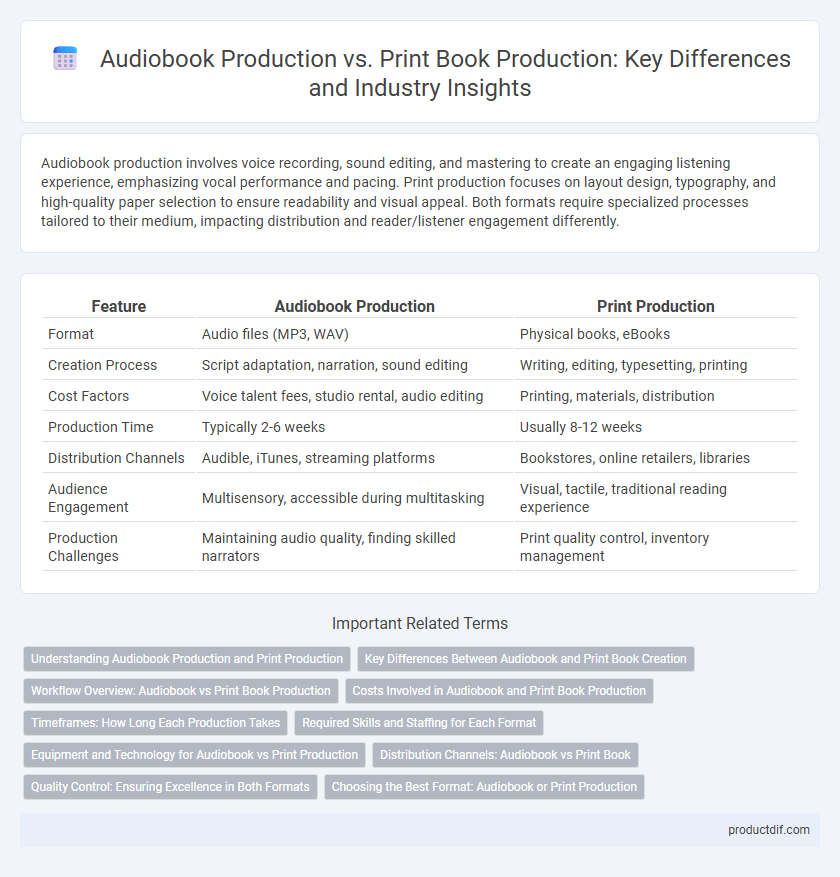Audiobook production involves voice recording, sound editing, and mastering to create an engaging listening experience, emphasizing vocal performance and pacing. Print production focuses on layout design, typography, and high-quality paper selection to ensure readability and visual appeal. Both formats require specialized processes tailored to their medium, impacting distribution and reader/listener engagement differently.
Table of Comparison
| Feature | Audiobook Production | Print Production |
|---|---|---|
| Format | Audio files (MP3, WAV) | Physical books, eBooks |
| Creation Process | Script adaptation, narration, sound editing | Writing, editing, typesetting, printing |
| Cost Factors | Voice talent fees, studio rental, audio editing | Printing, materials, distribution |
| Production Time | Typically 2-6 weeks | Usually 8-12 weeks |
| Distribution Channels | Audible, iTunes, streaming platforms | Bookstores, online retailers, libraries |
| Audience Engagement | Multisensory, accessible during multitasking | Visual, tactile, traditional reading experience |
| Production Challenges | Maintaining audio quality, finding skilled narrators | Print quality control, inventory management |
Understanding Audiobook Production and Print Production
Audiobook production involves recording narration, sound editing, and mastering to create an immersive listening experience, requiring specialized equipment and voice talent. Print production encompasses layout design, typesetting, printing, and binding, focusing on visual appeal and physical durability for distribution. Both processes demand attention to content accuracy and audience engagement but differ fundamentally in technology and sensory delivery.
Key Differences Between Audiobook and Print Book Creation
Audiobook production involves voice narration, sound engineering, and post-production editing to ensure clear audio quality and engaging delivery, unlike print production which focuses on typesetting, layout design, and physical printing processes. Narrator selection and recording environment are critical for audiobooks, while print books require attention to typography, cover design, and paper quality. Distribution channels also differ, with audiobooks primarily distributed on digital platforms versus traditional bookstores for print books.
Workflow Overview: Audiobook vs Print Book Production
Audiobook production involves script adaptation, voice casting, recording sessions, audio editing, and mastering, requiring specialized sound engineers and narrators to ensure clarity and engagement. Print book production focuses on manuscript editing, typesetting, layout design, proofreading, printing, and distribution, emphasizing visual elements and physical formatting. Both workflows demand coordination between creative and technical teams but differ substantially in mediums and post-production processes.
Costs Involved in Audiobook and Print Book Production
Audiobook production typically incurs higher costs due to expenses related to professional narrators, studio time, and audio editing, often ranging from $3,000 to $10,000 per finished hour. Print book production involves costs such as printing, paper, and binding, with expenses varying based on print run size, usually between $2 to $6 per copy for standard paperbacks. While print production has fixed physical materials costs, audiobook creation demands specialized labor and technology, impacting overall budget allocation significantly.
Timeframes: How Long Each Production Takes
Audiobook production typically requires four to six weeks, involving scripting, voice recording, editing, and mastering to ensure high-quality audio. Print production often takes longer, ranging from eight to twelve weeks due to manuscript finalization, typesetting, proofreading, and printing processes. Factors such as narration complexity and print format can influence these timeframes.
Required Skills and Staffing for Each Format
Audiobook production demands skilled voice actors, sound engineers, and audio editors proficient in narration, pacing, and sound quality enhancement, while print production requires experts in layout design, typesetting, proofreading, and print technology to ensure clarity and proper formatting. Staffing for audiobooks often includes casting directors and audio post-production specialists to manage recording sessions and editing, whereas print production relies on graphic designers and print managers to oversee the physical book creation process. Both formats necessitate project managers to coordinate timelines, but the technical skill sets differ significantly due to the distinct nature of audio versus tactile media.
Equipment and Technology for Audiobook vs Print Production
Audiobook production relies heavily on high-quality microphones, soundproof recording studios, and advanced audio editing software to ensure clear narration and immersive sound experiences. In contrast, print production depends on offset or digital printing presses, typesetting software, and paper quality control technologies to deliver sharp text and vibrant images. While audiobook technology emphasizes audio fidelity and voice modulation, print production technology prioritizes visual clarity and material durability.
Distribution Channels: Audiobook vs Print Book
Audiobook distribution channels primarily include digital platforms such as Audible, Apple Books, and Google Play, enabling instant global access and seamless integration with mobile devices. Print books rely on physical distribution through bookstores, libraries, and direct sales, often involving longer supply chains and higher logistics costs. The digital nature of audiobooks allows for rapid updates and expanded reach compared to traditional print distribution methods.
Quality Control: Ensuring Excellence in Both Formats
Quality control in audiobook production involves meticulous voice casting, sound engineering, and editing to deliver clear, engaging narration free from background noise or inconsistencies. Print production quality control focuses on accurate typesetting, color accuracy, paper quality, and binding durability to ensure a visually appealing and long-lasting physical book. Both formats require rigorous review processes and adherence to industry standards to maintain excellence and satisfy consumer expectations.
Choosing the Best Format: Audiobook or Print Production
Choosing between audiobook production and print production depends on target audience preferences, budget, and distribution channels. Audiobooks offer accessibility and engagement through professional narration and can reach visually impaired or multitasking listeners, while print production provides a tangible reading experience and collectible value. Evaluating factors like production costs, market demand, and content suitability helps determine the optimal format for maximizing reach and reader satisfaction.
Audiobook Production vs Print Production Infographic

 productdif.com
productdif.com